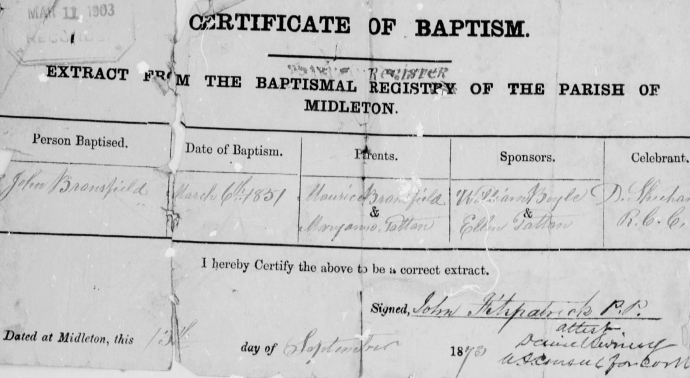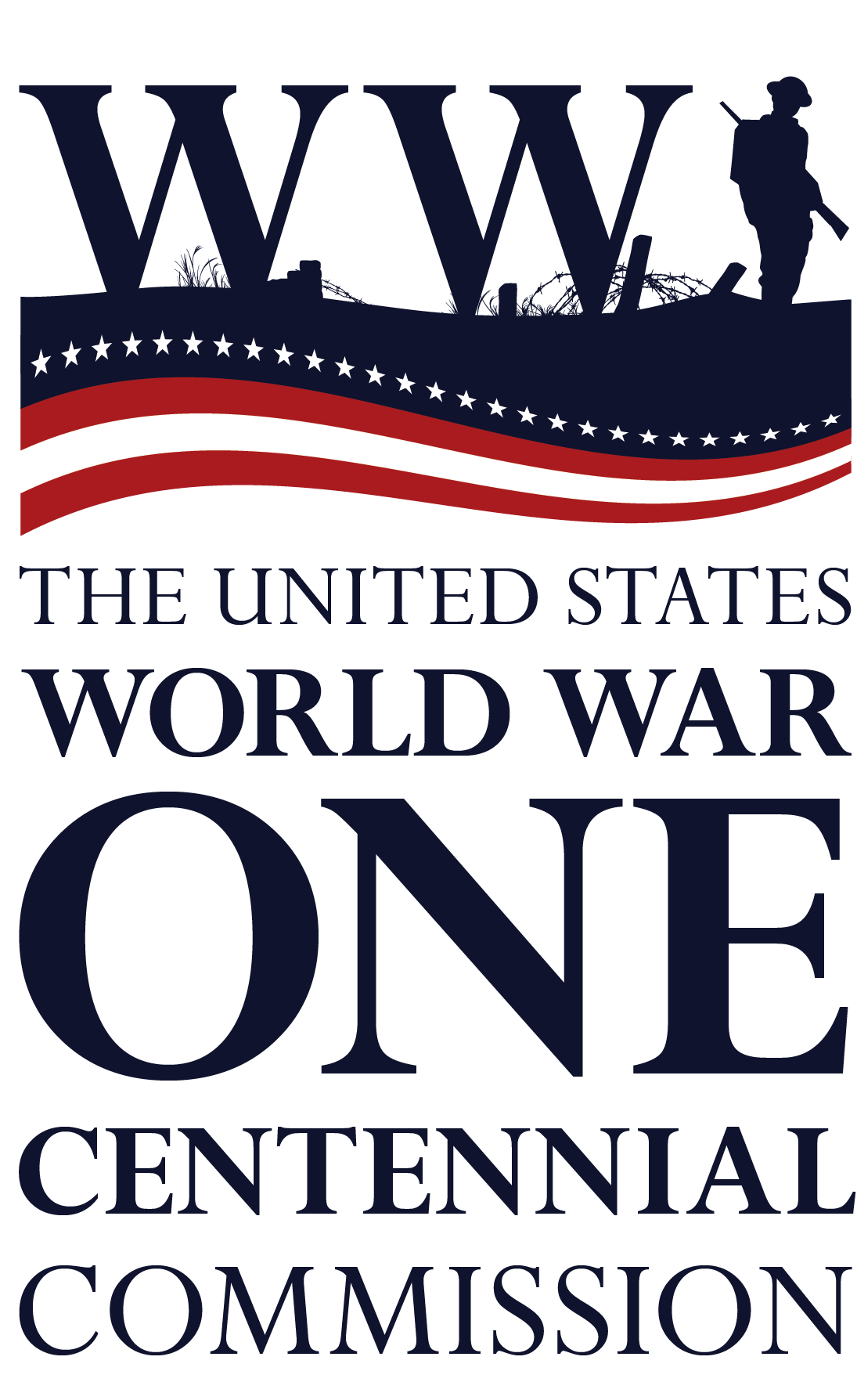On the site we have previously explored some of Midleton’s connections with the United States, and American military service. Probably our most influential discovery was the forgotten story of John Joseph Coppinger, as our research into him led to the naming and theming of Coppingers pub on Midleton’s Main Street. Though Coppinger is certainly Midleton’s most famous “forgotten” American serviceman, he is far from alone. This post takes a brief look at just three of many others from the area who entered American military service in the 19th century– one during the American Civil War, another immediately after that conflict, and one who served in both the American West and during the Spanish-American War.

The grave of John Joseph Coppinger in Arlington National Cemetery, Virginia, photographed during a visit to the site in 2014 (Damian Shiels)
John Quinn, 16th New York Cavalry, American Civil War
The American Civil War saw more Cork men fight and die in uniform than any other conflict in the county’s history, including the First World War. It is probable that the same is also true for Midleton men, and those from the immediate area. One of a number we have uncovered was John Quinn. John was born in East Cork around 1826. On 25th May 1845 he married 18-year-old Margaret Hennessy in Dromada, Castlemartyr, part of the parish of Midleton.

Marriage certification for John Quinn and Margaret Hennessy of Castlemartyr in 1845. Margaret supplied this evidence in her claim for an American pension after John’s death (NARA)
The couple went on to have at least two children, Margaret and Michael, both born in the early 1850s. They emigrated to New York and by the eve of the American Civil War were living in city of Troy, probably with other emigrants from East Cork. John enlisted in the 16th New York Cavalry on 10th August 1863 but illness soon caused him to be transferred to the Invalid Corps. He died in Alexandria, Virginia of chronic pneumonia on 11th February 1864. After John’s death, Margaret successfully applied for an American Military Pension based on her husband’s service. John’s resting place can today be found in Alexandria National Cemetery.

The grave of John Quinn in Alexandria National Cemetery, Virginia (Stan Jett via Find A Grave)
John J. Bransfield, USS Brooklyn, USS Ohio, USS Jaunita, Post Civil War
Born in Midleton, John was a 22-year-old sailmaker when he enlisted in the United States Navy in September 1870. His main service was aboard the famed sloop-of-war USS Brooklyn, and he spent his time deployed with her on her extended visit to Europe and the Mediterranean. John took ill while on the voyage, and while in Toulon, France was deemed unfit for service due to palpitations of the heart. He was discharged on 24th August 1872.

USS Brooklyn, on which Midleton’s John Bransfield served (United States Navy)
John received a pension for rheumatism and heart disease caused by his service. After leaving the navy he first lived at 140 Prince Street in Boston, and as was common, spent much of his time with other Midleton emigrants. Richard Morgan of Midleton remembered meeting him there when they worked together at the same employment. Eventually John returned to make his home on Midleton’s Main Street, where he spent the remainder of his life. He married Hannah Walsh on 7th November 1879; their son Maurice was born in 1880, and was followed by John in 1882, Dora in 1884 and Mary in 1885. John died in Cork’s North Infirmary on 12th November 1902 during an operation that was attempting to remove his kidney, and was buried in Midleton’s Holy Rosary Cemetery.

John Bransfield’s Certificate of Baptism from 1851. Supplied as part of his American pension application (NARA)

1903 Memorandum of Midleton’s John Stanton, Clerk of the Union, relating to the pension application of John Bransfield’s widow Hannah (NARA)
John Leahy, United States Marine Corps, Spanish-American War
John Leahy was born in Aghada around 1864, but his family ultimately made their home at No. 10 William Street (New Cork Road), Midleton. They would later move to No. 15. John had long service in the U.S. military. He was a 20-year-old labourer when he entered the 4th United States Cavalry in New York on 25th November 1887, serving in the American West with Company D. Discharged in 1891, he returned to the military in 1898 at Mare Island, California, when he re-enlisted in the United States Marine Corps. All the while John was sending money home to support his ageing parents in Midleton. During the Spanish-American War of 1898, John took part in some of the major actions of the conflict. He was a participant in the landing at Guantánamo, Cuba on 10th June 1898, the bombardment of Santiago de Cuba on 21st June and 2nd July 1898 and the destruction of Admiral Cervera’s fleet on 3rd July 1898.

U.S. Marines entrenching in Guantánamo, Cuba in 1898, an operation Midleton’s John Leahy participated in (U.S. Naval History & Heritage Command)
John survived these engagements only to fall ill and die on 7th October 1900. He was interred at the Congressional Cemetery in Washington D.C. His parents William and Ellen, who had partially relied on John’s financial support, were entitled to seek a U.S. Government pension in Ellen’s name, as William was no longer able to work. She duly applied for it.

The grave of Midleton’s John Leahy at Congressional Cemetery, Washington D.C. (Historic Congressional Cemetery Archivist via Find A Grave)
When seeking her pension, Ellen wrote from Midleton to the American Bureau of Pensions explaining her circumstances:
…my only outlook now is to look forward to the graciousness of the U.S. Government, as I was almost entirely dependent on my deceased son’s remittances to me, and my husband being unable to work owing to his advanced age, I now sadly miss my son’s remittances, owing to his untimely death in service to his adopted Country.

Letter written by Ellen Leahy from Midleton to America in support of her pension application based on her son’s U.S. Marine Corps service (NARA)
John wasn’t the only one of the Midleton Leahys in America. In fact his mother Ellen took the time in 1902 to explain to the American Government just where all her children were, and why they couldn’t support her:
(1) Michael Leahy (son) aged 40 years who is a Hospital Steward in [the] United States Army and is at present stationed at Angel Island, California…He is married and doing for himself and family and consequently is no help to me.
(2) Ellen Leahy (daughter) aged 37 years who is presumably in some part of the United States, but as she never writes home I have no account of her.
(3) Margaret Barry (daughter)…is wife of John Barry of Midleton County Cork Ireland. Her age in 1901 was 34 years.
(4) Mary White (daughter)…aged 31 years; wife of John White of Midleton County Cork Ireland.
(5) William Leahy (son); 28 years; is living with me at home.
(6) Kate Leahy (daughter); 26 years; is at present in some part of the United States.
(7) Patrick Leahy (son), 23 years, is living with me at home. [he suffered from fits]
(8) Annie Leahy (daughter), 20 years, is living with me at home.
My husband, William Leahy, aged 74 years is also alive an has never rendered any military or naval service. [he had worked as a labourer until he was 70, but was now too old to work for her support]
The impact of emigration in splitting families apart is readily apparent in Ellen’s account of her children. She and her husband provided lots of additional detail about their lives in their pension application, including the fact that they were renting their home on a weekly basis from Lord Midleton for a sum of one shilling and six pence. Other Midleton residents rallied around the couple to try and help them get a pension; among those who gave statements were Timothy O’Leary of 9 Railway Terrace, and Denis O’Keeffe of No. 19 William Street (New Cork Road). When Ellen herself fell ill, her daughter (and U.S. Marine John’s sister) Hannah Aherne, then living at No. 15 Cork Road, supplied receipts for her medical care to the U.S. Government, which are still preserved in Washington D.C. today. Among them is a bill from Doctor M.P. Desmond, which you can view below.

Receipt from Dr. Desmond for care of Ellen Leahy on the Cork Road (NARA)
After Ellen’s death on 10th March 1919, Hannah also passed a copy of the funeral expenses on to America, preserving the details of the costs issued by Dr. Patrick D. Moore of 3 Broderick Street for the provision of, among other items, a coffin, bier and horses. Hannah was entitled to be repaid the costs for both her mother’s illness and funeral because Ellen had been a pensioner of the United States– even though she had never visited the country.

Funeral expenses issued by Patrick D. Moore of 3 Broderick Street, Midleton, preserved in the National Archives, Washington D.C. (NARA)

Hannah Aherne’s 1920 letter to the American Bureau of Pensions seeking a contribution towards her mother’s funeral expenses to which she was entitled as her mother was a U.S. Pensioner (NARA)
The stories of these three men and their families are some of the thousands from East Cork that were created as a result of the mass emigration from the locality in the 19th and 20th centuries. That emigration led many to the service of the United States military, and unfortunately for some, it led to their deaths. We hope in the future to share more similar stories of Midleton and East Cork emigrants on the site.
This post would not have been possible were it not for the efforts of the National Archives and Records Administration staff in Washington D.C., who preserve and have digitised this material.
References
National Archives Pension Files
Find A Grave
U.S. Army Register of Enlistments
New York Muster Roll Database


